 | | | Switch to: Europe, USA, New Zealand, Antarctica Credit: NOAA/Ovation  Planetary K-index Planetary K-index
Now: Kp= 0 quiet
24-hr max: Kp= 2 quiet
explanation | more data
Interplanetary Mag. Field
Btotal: 4.7 nT
Bz: 1.7 nT north
more data: ACE, DSCOVR
Updated: Today at 2345 UT  Coronal Holes: 26 Oct 21 Coronal Holes: 26 Oct 21 
There are no significant coronal holes on the Earthside of the sun. Credit: SDO/AIA  Noctilucent Clouds The northern hemisphere season for noctilucent clouds appears to be over. NASA's AIM spacecraft detected no evidence of NLCs around the north pole on Aug. 29th. Switch view: Europe, USA, Asia, Polar Updated at: Noctilucent Clouds The northern hemisphere season for noctilucent clouds appears to be over. NASA's AIM spacecraft detected no evidence of NLCs around the north pole on Aug. 29th. Switch view: Europe, USA, Asia, Polar Updated at:  SPACE WEATHER
NOAA Forecasts | | Updated at: 2021 Oct 26 2200 UTC FLARE | 0-24 hr | 24-48 hr | CLASS M | 25 % | 15 % | CLASS X | 10 % | 05 % |  Geomagnetic Storms: Geomagnetic Storms:
Probabilities for significant disturbances in Earth's magnetic field are given for three activity levels: active, minor storm, severe storm Updated at: 2021 Oct 26 2200 UTC Mid-latitudes | 0-24 hr | 24-48 hr | ACTIVE | 10 % | 15 % | MINOR | 01 % | 05 % | SEVERE | 01 % | 01 % | High latitudes | 0-24 hr | 24-48 hr | ACTIVE | 15 % | 15 % | MINOR | 20 % | 25 % | SEVERE | 15 % | 25 % | | | |  | | | | | | | | | | | Lights Over Lapland has a full catalogue of exciting adventures in Abisko National Park, Sweden! Check out our daytime and evening activities and book your adventure! | | | SOMETHING FLARE-Y THIS WAY COMES: Suddenly, the northeastern limb of the sun is bursting with activity. NASA's Solar Dynamics Observatory recorded this frenetic 5-hour sequence during the early hours of Oct. 26th: 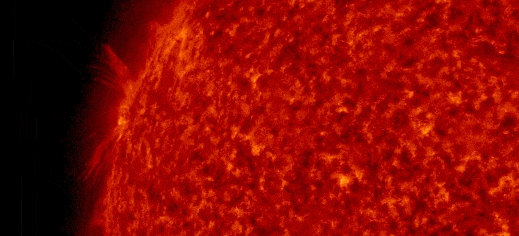
At least half a dozen explosions occured during that brief movie. The blast site is hidden just behind the edge of the sun. It's almost certainly an unstable sunspot. The sun's rotation will bring it into view within the next 24-48 hours, creating a geoeffective source of solar activity. Solar flare alerts: SMS Text. more images: from Martin Wise of Trenton, Florida; from Apollo Lasky of Naperville, Illinois; from Sylvain Weiller of Jerusalem, Israel; from Maximilian Teodorescu of Magurele, Romania; COMET 29P ERUPTS AGAIN: The British Astronomical Association (BAA) is reporting another strong outburst of Comet 29P/Schwassmann-Wachmann. The volcanic comet suddenly brightened 10-fold on Oct. 23.75 UT when a sunlit vent opened, spewing 'cryomagma' into space. Dr. Richard Miles of the BAA provided this light curve: 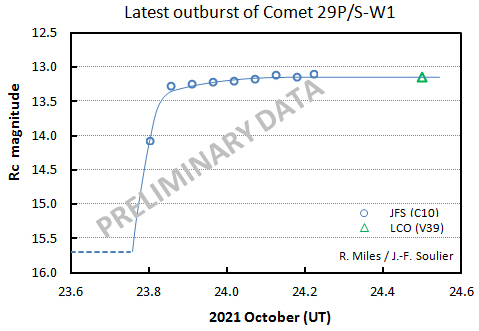
Comet 29P is one of the strangest objects in the solar system. In fact, it strains the definition of "comet." 29P is a ball of ice 60 km wide (much larger than a typical comet) trapped in a planet-like orbit between Jupiter and Saturn. It appears to be festooned with ice volcanoes which erupt ~20 times a year. A rapidfire "super-eruption" of 4 volcanoes in late September created an expanding shell of vaporized cryomagma, which astronomers have been monitoring. Yesterday's eruption propelled a new compact shell into the old larger one: 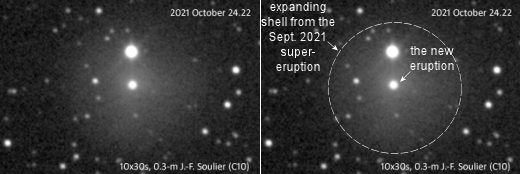
Above: Comet 29P photographed less than 12 hours after the Oct. 23rd eruption. Credit: Jean-Francois Soulier of France.
29P rotates once every ~58 days. As sunlight sweeps across its frozen surface, cryovolcanoes erupt under the high sun. "The latest eruption has taken place some 59 days after a similar event on August 25th, and may be an example of an outburst from the same cryovolcano erupting a second time on the next rotation of the nucleus," says Miles. Amateur astronomers with mid-sized telescopes and astrophotography experience are encouraged to monitor 29P. It changes every night. The comet is located in the constellation Auriga, high in the northern sky at midnight. Point your optics here and check the BAA's Mission 29P website for updates. more images: from Eliot Herman using a telescope in Mayhill, New Mexico Realtime Space Weather Photo Gallery
Free: Spaceweather.com Newsletter
VOYAGER GOLDEN RECORD ORNAMENT: This is a must-have Christmas ornament for space fans: The Voyager Golden Record. On Oct. 15th, the students of Earth to Sky Calculus launched it to the stratosphere onboard a cosmic ray research balloon:
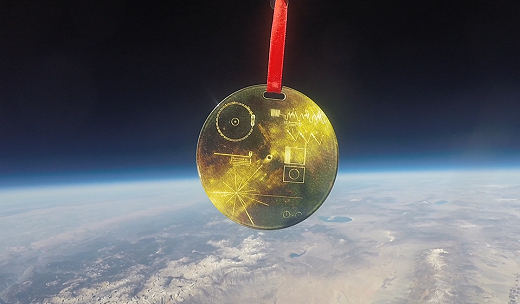
You can have it for $129.95. The 4-inch aluminum disk is imprinted with instructions intended for extraterrestrials, telling them how to play the phonographs now sailing through interstellar space onboard NASA's Voyager probes. Having touched the edge of space, it's the closest thing on Earth to an actual Golden Record. The students are selling these unique ornaments to support their cosmic ray ballooning program. Each one comes with a greeting card showing the ornament in flight and extra materials decoding the markings on the disk. Far Out Gifts: Earth to Sky Store
All sales support hands-on STEM education
Realtime Aurora Photo Gallery
Free: Spaceweather.com Newsletter Every night, a network of NASA all-sky cameras scans the skies above the United States for meteoritic fireballs. Automated software maintained by NASA's Meteoroid Environment Office calculates their orbits, velocity, penetration depth in Earth's atmosphere and many other characteristics. Daily results are presented here on Spaceweather.com. On Oct 26, 2021, the network reported 39 fireballs.
(25 sporadics, 9 Orionids, 4 southern Taurids, 1 epsilon Geminid) 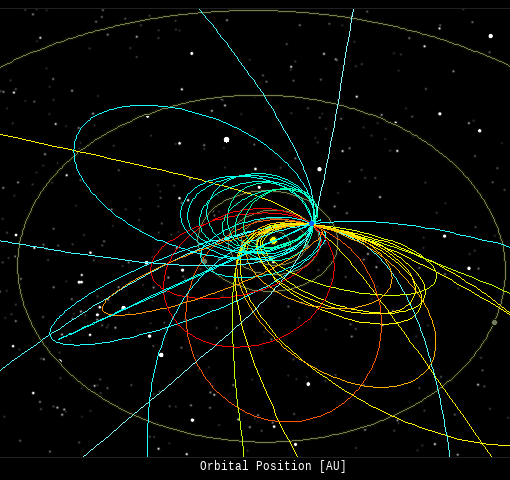 In this diagram of the inner solar system, all of the fireball orbits intersect at a single point--Earth. The orbits are color-coded by velocity, from slow (red) to fast (blue). [Larger image] [movies] Potentially Hazardous Asteroids ( PHAs) are space rocks larger than approximately 100m that can come closer to Earth than 0.05 AU. None of the known PHAs is on a collision course with our planet, although astronomers are finding new ones all the time. On October 26, 2021 there were 2226 potentially hazardous asteroids.
 | Recent & Upcoming Earth-asteroid encounters: | Asteroid | Date(UT) | Miss Distance | Velocity (km/s) | Diameter (m) | | 2021 TV3 | 2021-Oct-21 | 13.2 LD | 12.6 | 47 | | 2021 UB1 | 2021-Oct-21 | 8.6 LD | 8.7 | 14 | | 2021 UQ | 2021-Oct-21 | 8 LD | 14 | 61 | | 2021 TE4 | 2021-Oct-21 | 8.3 LD | 6 | 15 | | 2021 SG2 | 2021-Oct-21 | 15.9 LD | 5.9 | 25 | | 2021 RE10 | 2021-Oct-21 | 15.5 LD | 5.1 | 56 | | 2021 UU | 2021-Oct-23 | 4.8 LD | 11.2 | 18 | | 2021 UY | 2021-Oct-23 | 3.8 LD | 6 | 10 | | 2021 TE1 | 2021-Oct-23 | 9.4 LD | 12.4 | 47 | | 2021 UT | 2021-Oct-24 | 0.4 LD | 11.2 | 5 | | 2021 UA1 | 2021-Oct-25 | 0 LD | 15.8 | 2 | | 2017 SJ20 | 2021-Oct-25 | 18.7 LD | 15.7 | 120 | | 2021 TO15 | 2021-Oct-25 | 7.3 LD | 12.6 | 33 | | 2019 UW6 | 2021-Oct-26 | 8 LD | 11.1 | 17 | | 2021 UC1 | 2021-Oct-27 | 12.4 LD | 8.3 | 30 | | 2021 UX | 2021-Oct-27 | 2.9 LD | 18.8 | 20 | | 2021 UV | 2021-Oct-27 | 2.3 LD | 16.1 | 17 | | 2009 WY7 | 2021-Nov-02 | 19.2 LD | 14.7 | 54 | | 2021 TJ14 | 2021-Nov-02 | 19 LD | 9.6 | 40 | | 2017 TS3 | 2021-Nov-02 | 13.9 LD | 9.9 | 131 | | 2005 VL1 | 2021-Nov-04 | 17 LD | 5.2 | 18 | | 2020 KA | 2021-Nov-06 | 14.9 LD | 4.8 | 11 | | 2021 SP3 | 2021-Nov-08 | 15.6 LD | 9.3 | 70 | | 2019 XS | 2021-Nov-09 | 1.5 LD | 10.7 | 65 | | 2017 WG14 | 2021-Nov-10 | 18.6 LD | 11.6 | 45 | | 2007 VD138 | 2021-Nov-12 | 16 LD | 7.7 | 44 | | 2004 UE | 2021-Nov-13 | 11.1 LD | 13.2 | 224 | | 2016 VR | 2021-Nov-15 | 8 LD | 8.7 | 20 | | 2010 VK139 | 2021-Nov-15 | 6.4 LD | 13.9 | 65 | | 2019 VL5 | 2021-Nov-15 | 8.6 LD | 8 | 23 | | 2016 JG12 | 2021-Nov-20 | 14.4 LD | 7.5 | 112 | | 2021 TR15 | 2021-Nov-20 | 11.9 LD | 7 | 38 | | 2021 KH2 | 2021-Nov-21 | 19.3 LD | 6.5 | 31 | | 3361 | 2021-Nov-21 | 15.1 LD | 8.1 | 511 | | 2014 WF201 | 2021-Nov-24 | 13.2 LD | 5.5 | 27 | | 2009 WB105 | 2021-Nov-25 | 15.1 LD | 18.9 | 71 | | 2019 BB5 | 2021-Nov-25 | 18.8 LD | 8.3 | 16 | | 1994 WR12 | 2021-Nov-29 | 16.1 LD | 8.8 | 123 | | 4660 | 2021-Dec-11 | 10.3 LD | 6.6 | 774 | | 2019 XQ1 | 2021-Dec-13 | 14.1 LD | 9.1 | 30 | | 2004 YC | 2021-Dec-15 | 18.4 LD | 8.1 | 27 | | 163899 | 2021-Dec-17 | 14.2 LD | 5.6 | 1083 | | 2021 LX3 | 2021-Dec-18 | 19.7 LD | 6.5 | 124 | | 2016 YY10 | 2021-Dec-21 | 11.3 LD | 9.2 | 23 | | 2017 XQ60 | 2021-Dec-21 | 13.7 LD | 15.7 | 47 | | 2016 TR54 | 2021-Dec-24 | 16.9 LD | 15.5 | 135 | Notes: LD means "Lunar Distance." 1 LD = 384,401 km, the distance between Earth and the Moon. 1 LD also equals 0.00256 AU. MAG is the visual magnitude of the asteroid on the date of closest approach. | | Cosmic Rays in the Atmosphere | SPACE WEATHER BALLOON DATA: Almost once a week, Spaceweather.com and the students of Earth to Sky Calculus fly space weather balloons to the stratosphere over California. These balloons are equipped with sensors that detect secondary cosmic rays, a form of radiation from space that can penetrate all the way down to Earth's surface. Our monitoring program has been underway without interruption for 6 years, resulting in a unique dataset of in situ atmospheric measurements. Latest results: Our most recent flight on June 25, 2021, confirms a trend of decreasing cosmic radiation: 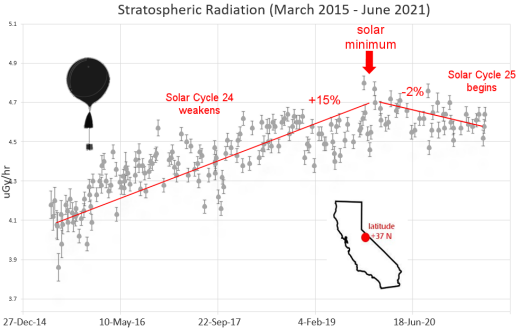
Cosmic ray dose rates peaked in late 2019, and have been slowly declining ever since. This makes perfect sense. Solar Minimum was in late 2019. During Solar Minimum the sun's magnetic field weakens, allowing more cosmic rays into the solar system. We expect dose rate to be highest at that time. Now that Solar Minimum has passed, the sun is waking up again. Solar magnetic fields are strengthening, providing a stiffer barrier to cosmic rays trying to enter the solar system. The decline of cosmic radiation above California is a sign that new Solar Cycle 25 is gaining strength. .Who cares? Cosmic rays are a surprisingly "down to Earth" form of space weather. They can seed clouds, trigger lightning, and penetrate commercial airplanes. According to a study from the Harvard T.H. Chan school of public health, crews of aircraft have higher rates of cancer than the general population. The researchers listed cosmic rays, irregular sleep habits, and chemical contaminants as leading risk factors. Somewhat more controversial studies (#1, #2, #3, #4) llink cosmic rays with cardiac arrhythmias and sudden cardiac death. En route to the stratosphere, our sensors also pass through aviation altitudes: 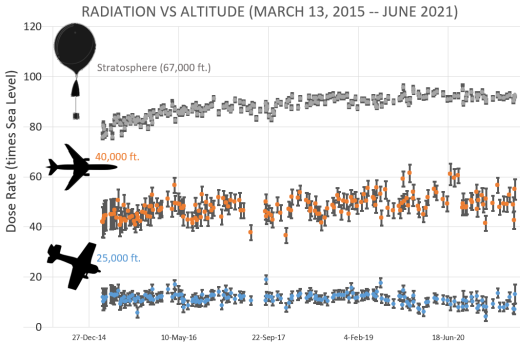
In this plot, dose rates are expessed as multiples of sea level. For instance, we see that boarding a plane that flies at 25,000 feet exposes passengers to dose rates ~10x higher than sea level. At 40,000 feet, the multiplier is closer to 50x. The higher you fly, the more radiation you will absorb. Technical notes: The radiation sensors onboard our helium balloons detect X-rays and gamma-rays in the energy range 10 keV to 20 MeV. These energies span the range of medical X-ray machines and airport security scanners. Data points in the first graph ("Stratospheric Radiation") correspond to the peak of the Regener-Pfotzer maximum, which lies about 67,000 feet above central California. When cosmic rays crash into Earth's atmosphere, they produce a spray of secondary particles that is most intense at the entrance to the stratosphere. Physicists Eric Regener and Georg Pfotzer discovered the maximum using balloons in the 1930s and it is what we are measuring today. | | The official U.S. government space weather bureau | | | The first place to look for information about sundogs, pillars, rainbows and related phenomena. | | | Researchers call it a "Hubble for the sun." SDO is the most advanced solar observatory ever. | | | 3D views of the sun from NASA's Solar and Terrestrial Relations Observatory | | | Realtime and archival images of the Sun from SOHO. | | | information about sunspots based on the latest NOAA/USAF Active Region Summary | | | from the NOAA Space Environment Center | | | fun to read, but should be taken with a grain of salt! Forecasts looking ahead more than a few days are often wrong. | | | from the NOAA Space Environment Center | | | the underlying science of space weather |  | Going above and beyond to provide the best homes listings in the Comox real estate market to keep you up to date and informed |  | One of the most popular casino games is the Book Of Dead Slot based on ancient Egyptian text, you can find all the casinos with spins at bookofdeadslotsites.com. |  | When looking for casinos to play online when the weather is bad, you can try luotettavat nettikasinot for Finnish games. If you are not from Finland you can try the Swedish page Svenska casino online to find suitable games, check out svenskacasinoonline.net. Always check your local laws before playing with real money. |  | Finns rank fourth among the world’s biggest gamblers. More on Finnish online casinos you can find at Nettikasino site. |  | To find reviews of new online casino sites in the UK try The Casino DB where there are hundreds of online casino reviews complete with bonuses and ratings. Alternatively, Online-Casinos.xyz is another massive directory of online casinos listing sites for the UK and Worldwide. Casinos that offer Rupees for bonuses are very generous to Indian players. Find the best online casinos in India at AllCasinos.in Looking for a new online casino? Try Casimpo the new site dedicated to making online casino simple, or check out the new Avenger Slots Casino and Ace Online Casino with over 500 online slots and casino games. | | | These links help Spaceweather.com stay online. Thank you to our supporters! | | | | | | | | |  | |  |   | ©2021 Spaceweather.com. All rights reserved. This site is penned daily by Dr. Tony Phillips. | |

